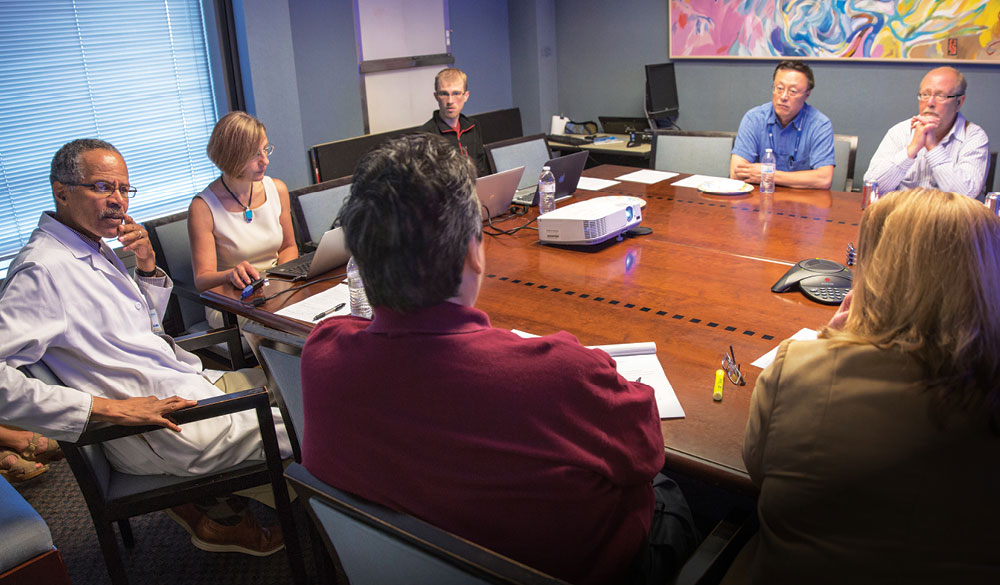
Thinking outside the box
Innovation groups attack thorny cancer problems
As the saying goes, “It takes a village to raise a child,” and nurturing cancer research toward maturity and independence is no different.
At UC Davis Comprehensive Cancer Center, where individual discoveries are made in exam rooms, far-flung laboratories, operating rooms, radiology suites and even on desktop computers, harnessing and exploiting that knowledge to improve patient care and survival can be challenging.
That’s why Karen Kelly, a lung cancer specialist and associate director for clinical research at the cancer center, launched seven clinical “innovation groups,” which meet regularly to discuss cancer challenges, propose ways to tackle them, apply jointly for grants to fund the research, and work together to accomplish the projects.
“What we are trying to do is leverage the talent at UC Davis so that it can translate to improved patient outcomes,” says Kelly. “That is the ultimate goal.”
Bringing together multidisciplinary teams to approach problems of a particular type of cancer can speed and streamline the process of discovery — and its translation to the clinic, where patients can more quickly benefit from it. Each group includes at least one laboratory scientist, medical oncologist, pathologist, radiologist, radiation oncologist, surgeon and other specialists, as appropriate.
“This way, we get all of the stakeholders at the table to try to come up with the most innovative, impactful grant and/or investigator-initiated trial that our patients have an opportunity take advantage of,” Kelly adds.
After just one year of operation, the groups already have been awarded four research grants and submitted an additional two now under consideration for funding. In addition, the groups have launched five investigator-initiated clinical trials (trials of new drugs or treatment approaches designed by physicians and not sponsored by industry), and have seven other such trials in the works.
The brain innovation group sparked development of one of the grants. Biomedical engineer Laura Marcu attended a meeting and talked about her fluorescent probe that can differentiate various tissue types in ways that the human eye cannot. That prompted a discussion about a specific challenge in brain tumor treatment that involves tissue that has died as a result of radiation treatment.
“I had been dealing with a patient with radiation necrosis,” explains Ruben Fragoso, a radiation oncologist. “It’s difficult to tell the difference between necrosis and tumor. We wondered if there was anything we could use to try to tell the difference.”
Fragoso’s dilemma was developed into a grant proposal, which was later funded by the National Cancer Institute. A clinical study is under way to see if the probe could spare patients unnecessary additional surgery by informing the surgeon whether the tissue is cancerous before incisions are made.
“These innovation groups bring people with different perspectives together,” Fragoso says. “You get new ideas and bridge different disciplines you wouldn’t otherwise. Who would have thought about an optic biopsy probe?”
Brian Jonas, a hematologist who specializes in and researches adult blood cancers, considers the groups “think tanks.” He is an active member of the hematological malignancies and phase I clinical trials innovation groups. With the hematological malignancies group, Jonas teamed with pediatric oncologist and researcher Noriko Satake to develop a bone marrow failure tissue bank to complement the cancer center’s biorepository, and that could benefit research on children and adults with blood cancers.
At an August meeting of the phase I clinical trials innovation group, participants discussed collaborations that could result in a grant designed for projects that involve imaging or image-guided interventions in cancer. Jonas proposed a research study on use of a novel and non-invasive imaging approach to evaluate myelofibrosis, a malignant bone marrow disorder that is currently detected through bone marrow biopsy.
“This gets everyone together to bounce ideas back and forth,” Jonas says of the meetings. “Not all ideas become priorities, but all it takes is a thought, and the next thing might be, ‘Hey, you should do this.’ The diversity of the group stimulates that type of discussion.”
For basic scientist John Albeck, who works in a laboratory on the UC Davis campus, participating in the lung cancer innovation group has been a kind of reality check.
“It forces me to think about how to make what we do useful,” he says. “I work on cells in a dish. The group goes beyond the cells and asks, ‘How does my work relate to actual organisms?’ Just thinking about that for an hour a month brings you back to reality. When I go back to my cells, what am I going to learn from them that will be really useful and biologically meaningful?”
Albeck’s research in the Department of Molecular and Cellular Biology focuses on certain cellular pathways common to lung cancer. Along with David Gandara, director of thoracic oncology at the cancer center, and Phil Mack, who leads the cancer center’s molecular pharmacology shared resource, Albeck has submitted a grant proposal to use mouse models capable of growing human lung tumors to test various treatment strategies. The goal is to find drugs that inhibit cellular pathways that allow tumors to grow and that don’t eventually fail, as many ultimately do.
“For any study, if you want to do effective cancer research, you really have to know the people who are actually working with patients,” he says. “I don’t think you really do cancer research without a group like this anymore.”
Kelly explained that the groups are successful because they are more than just brainstorming sessions. Karol Kyte, an analyst and assistant to Kelly, was tapped as administrator for each group and works hard to keep members on task and moving forward. Each group is also required to write annual progress reports.
“They are doing what we asked them to do,” Kelly says. “They are finding research opportunities based on UC Davis strengths and developing weakness into opportunities.”
